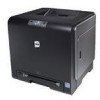Dell 1320c User Guide - Page 81
For Windows, XP, Windows XP 64-bit Edition, Windows Server, and Windows 2000, For Windows Vista, - network not available
 |
UPC - 662919013061
View all Dell 1320c manuals
Add to My Manuals
Save this manual to your list of manuals |
Page 81 highlights
This method is usually the best use of system resources. The server handles driver modifications and print job processing. This lets network clients return to their programs much faster. If you use the point and print method, a subset of driver information is copied from the server to the client computer. This is just enough information to send a print job to the printer. For Windows® XP, Windows XP 64-bit Edition, Windows Server® 2003, and Windows 2000: 1. On the Windows desktop of the client computer, double-click My Network Places. 2. Locate the host name of the server computer, and then double-click the host name. 3. Right-click the shared printer name, and then click Connect. Wait for the driver information to copy from the server computer to the client computer, and for a new printer object to be added to the Printers and Faxes (Printers for Windows 2000) folder. The copy time varies, based on network traffic and other factors. Close My Network Places. 4. Print a test page to verify print installation. 5. Click Start® Settings® Printers and Faxes (Printers for Windows 2000). 6. Select the printer you just created. 7. Click File® Properties. 8. From the General tab, click Print Test Page. When a test page prints successfully, printer installation is complete. For Windows Vista® and Windows Server 2008: 1. On the Windows desktop of the client computer, click Start® Network. 2. Locate the host name of the server computer, and then double-click the host name. 3. Right-click the shared printer name, and then click Connect. 4. Click Install driver. 5. Click Continue in User Account Control dialog. 6. Wait for the driver information to copy from the server computer to the client computer, and for a new printer object to be added to the Printers folder. The time this takes varies, based on network traffic and other factors. 7. Print a test page to verify print installation. 8. Click Start® Control Panel. 9. Select Printer. 10. Right-click the printer you just created and select Properties. 11. From the General tab, click Print Test Page. When a test page prints successfully, printer installation is complete. Peer-to-Peer If you use the peer-to-peer method, the printer driver is fully installed on each client computer. Network clients retain control of driver modifications. The client computer handles the print job processing. For Windows® XP, Windows XP 64-bit Edition, Windows Server® 2003, and Windows 2000: 1. Click Start® Settings® Printers and Faxes (Printers for Windows 2000). 2. Click Add Printer to launch the Add Printer wizard. 3. Click Next. 4. Select A network printer, or a printer attached to another computer, and then click Next (For Windows 2000, select the network printer from the Shared printers list). If the printer is not listed, type in the path of the printer in the text box. For example: \\\ The server host name is the name of the server computer that identifies it to the network. The shared printer name is the name assigned during the server installation process. 5. Click Browse for a printer, and then click Yes (For Windows 2000, click OK). If this is a new printer, you may be prompted to install a printer driver. If no system driver is available, then you will need to provide a path to available drivers. 6. Select whether you want this printer to be the default printer for the client, click Next, and then click Finish (For Windows 2000, click Finish). 7. Print a test page to verify printer installation: a. Click Start® Settings® Printers and Faxes (Printers for Windows 2000).















